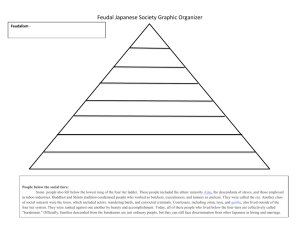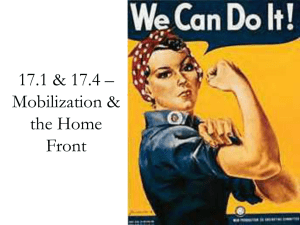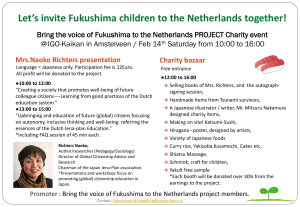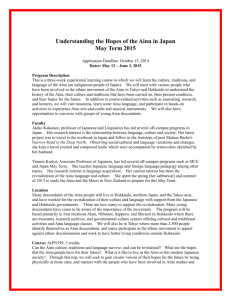Syllabus-128-2014 - UCSC Directory of individual web sites
advertisement
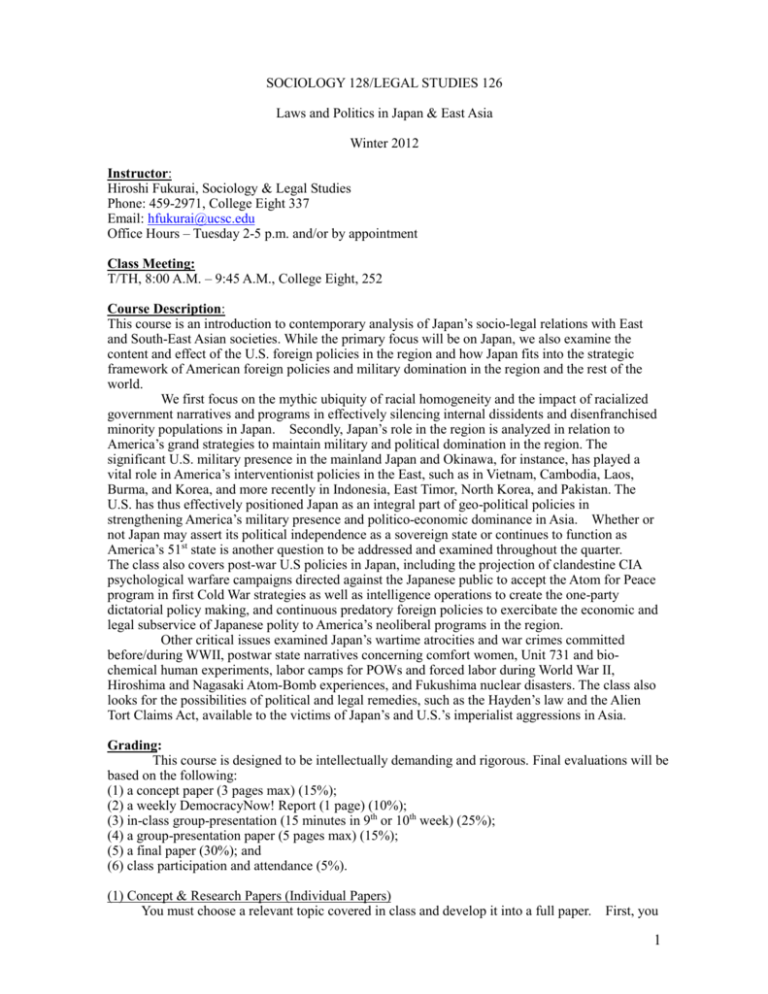
SOCIOLOGY 128/LEGAL STUDIES 126 Laws and Politics in Japan & East Asia Winter 2012 Instructor: Hiroshi Fukurai, Sociology & Legal Studies Phone: 459-2971, College Eight 337 Email: hfukurai@ucsc.edu Office Hours – Tuesday 2-5 p.m. and/or by appointment Class Meeting: T/TH, 8:00 A.M. – 9:45 A.M., College Eight, 252 Course Description: This course is an introduction to contemporary analysis of Japan’s socio-legal relations with East and South-East Asian societies. While the primary focus will be on Japan, we also examine the content and effect of the U.S. foreign policies in the region and how Japan fits into the strategic framework of American foreign policies and military domination in the region and the rest of the world. We first focus on the mythic ubiquity of racial homogeneity and the impact of racialized government narratives and programs in effectively silencing internal dissidents and disenfranchised minority populations in Japan. Secondly, Japan’s role in the region is analyzed in relation to America’s grand strategies to maintain military and political domination in the region. The significant U.S. military presence in the mainland Japan and Okinawa, for instance, has played a vital role in America’s interventionist policies in the East, such as in Vietnam, Cambodia, Laos, Burma, and Korea, and more recently in Indonesia, East Timor, North Korea, and Pakistan. The U.S. has thus effectively positioned Japan as an integral part of geo-political policies in strengthening America’s military presence and politico-economic dominance in Asia. Whether or not Japan may assert its political independence as a sovereign state or continues to function as America’s 51st state is another question to be addressed and examined throughout the quarter. The class also covers post-war U.S policies in Japan, including the projection of clandestine CIA psychological warfare campaigns directed against the Japanese public to accept the Atom for Peace program in first Cold War strategies as well as intelligence operations to create the one-party dictatorial policy making, and continuous predatory foreign policies to exercibate the economic and legal subservice of Japanese polity to America’s neoliberal programs in the region. Other critical issues examined Japan’s wartime atrocities and war crimes committed before/during WWII, postwar state narratives concerning comfort women, Unit 731 and biochemical human experiments, labor camps for POWs and forced labor during World War II, Hiroshima and Nagasaki Atom-Bomb experiences, and Fukushima nuclear disasters. The class also looks for the possibilities of political and legal remedies, such as the Hayden’s law and the Alien Tort Claims Act, available to the victims of Japan’s and U.S.’s imperialist aggressions in Asia. Grading: This course is designed to be intellectually demanding and rigorous. Final evaluations will be based on the following: (1) a concept paper (3 pages max) (15%); (2) a weekly DemocracyNow! Report (1 page) (10%); (3) in-class group-presentation (15 minutes in 9th or 10th week) (25%); (4) a group-presentation paper (5 pages max) (15%); (5) a final paper (30%); and (6) class participation and attendance (5%). (1) Concept & Research Papers (Individual Papers) You must choose a relevant topic covered in class and develop it into a full paper. First, you 1 must identify a topic and submit a 3 page concept paper for a critical review. The paper must explain: (1) why you become interested in the topic of your choice; (2) what you expect to find out; and (3) a list of five books/articles/sources to be used for your paper. You can make a short presentation to the class about your paper topic (option), and produce a final version of your own paper by the end of the quarter. The concept paper (3 page max, excluding a cover sheet and a bibliography) is due on February 9th, and the final paper (10 page max) is due on March 19, 12 p.m. The final paper can be one of two types: (1) a REVIEW PAPER (that describes, summarizes, and reviews existing knowledge about a major question or topic (e.g., cause, effect, and/or aftermath of the Fukushima nuclear disaster, ethnic conflicts and political struggles in an Asian country of your own choosing, such as race/ethnic conflicts in an Asian country of your choice, war crimes such as comfort women, forced labor at war camps, UNIT 731 biological experiments, and Nanjing massacre; state narratives of Hiroshima experience; effect and/or possible application of the Alien Tort Statute as legal remedies for victims of human rights violation. More contemporary topics may include Myanmar’s military regime and political struggles, the extent of CIA activities in an Asian country of your choosing, Unocal’s construction of oil pipelines with Burma’s forced labor, East Timor massacre, U.S. colonialism policies in Philippine, Vietnam war and geo-environment catastrophe (agents orange, cluster bombs, etc), introduction of Korea’s jury system in 2008, Japan’s mixed court in 2009, China’s lay assessor system in 2004.), OR (2) a RESEARCH PAPER (e.g., surveys or interviews with people, or analysis of archival data, etc). The requirements for the final paper (and the required format) are described in detail at the end of this syllabus. (2) In-Class Group-Presentation in 9th and 10th Week A group of students (3-4) will be asked to make a presentation on the detailed history of a East, South, or South-East Asian country of their choosing. The presentation must include the following: (1) pre-colonial history of a race/ethnic diversity including the discussion on languages, life-styles, and self-sustaining culture, prior to the arrival of Europeans; (2) detailed analysis of colonial experiences, including the detailed process of conquest, colonialism, and “genocide”; (3) “post-colonial” experience, including the transformation of race/ethnic relations, any remnants of self-sustaining culture, as well as discussions on the content of “post-colonial” satellite relations with the colonizing country. Some countries had experienced impositions of multiple European colonial powers and the presentation must include the analysis of respective processes of colonialism projected in that country. The 5-page group-paper must be turned in by the end of 8th week (i.e., March 1). Please make sure to specify names of co-presenters (i.e., co-authors) on the first coversheet of the paper, along with the title of your presentation. The evaluation will be based on how well each student speaks about his/her findings in an effective and engaging fashion. There are 15 slots available for the presentation. The signup sheet will be distributed later in the quarter. Every student must be involved in one of the presentations (as part of collective group efforts). (3) Weekly Report (7 one-page weekly reports) You are required to watch/read one of the following weekday programs including: (1) daily, one-hour daily news program (M-F), DemocracyNow! (www.democracynow.org); (2) Aljazeera English (http://www.aljazeera.com/watch_now/); (3) RT News (http://www.livestation.com/channels/18-rtenglish); (4) Press TV (http://www.presstv.ir/live/#); and/or (5) BBC World News (http://www.bbc.co.uk/news/world/). Please submit a one-page report on every Tuesday morning at 8 a.m. in class. The first report should be turned in on January 17th, examining at least one legal or political issue related to Asia from the previous week’s news program. Please include a brief discussion of socio-legal subjects involved in the issues. The report should be a one-page, doublespaced report. (4) Class Attendance and Participation: The evaluation will also be based on attendance, reading preparedness, and class contribution to discussions. The first 10 minutes of the class will be spent on the discussion of topic(s) covered 2 in DemocracyNow! Your physical presences as well as intellectual participation is essential in getting the most out of this course. The attendance sheet will be distributed in class. Plagiarism & Fabrication: Plagiarism will not be tolerated. You must be responsible in taking great care to distinguish, and make salient use of, your own ideas and knowledge from information derived from primary/secondary sources. In case of using a direct quotation or a paraphrase extracted from the source, it must be placed properly within quotation marks. All other paraphrased information must also be cited properly with the primary/secondary sources. Text: E-Book: Jeff Kingston, Tsunami: Japan’s Post-Fukushima Future (2011). Please purchase this E-book through the following website: http://www.foreignpolicy.com/ebooks/tsunami_japans_post_fukushima_future ($4.99) Reader: Unless the reading is given URL or other online site, all of the weekly reading materials listed below are included in the Reader (Available at the UCSC Copy Center) Course Contents: The class materials consist of guest speakers, short videos, and/or movies to gain deeper understandings of weekly subjects. Week 1 Japan, Internal Politics, & the Role of Japanese State in Global Politics 1/10 Introduction to the Course on Japan, Its Political Role, and the Future in Asia Michael Weiner, Japan’s Minorities: Illusion of Homogeneity (1997), Chapter 1 “The invention of identity: “Self’ and “other” in pre-war Japan, pp.1-16. Timothy Webster, Insular Minorities: International Law’s Challenge to Japan’s Ethnic Homogeneity, 36 N.C.J. Int’l L. & Comp. Reg. 557 (2011) 1/12 Nuclear Gypsies, Japan’s Minorities & Fukushima Nuclear Disaster Ningyo Toge & dumping site in White Mesa Mill, south of Blanding, Utah Uranium Mine in Indian Reservation & Abrigeonal lands in Australia Adam Clark Estes, Japan’s ‘Nuclear Gypsies’: The Latest Addition to the Fukushima Crew, Atlantic Wire, July 13, 2011. WISE (World Information Service on Energy), “Decommissioning Projects in Asia” (see under Japan) Suzanne M. Sable, “Democracy Abroad, Pride, Prejudice, and Japan’s United State,” 11 D.C.L. Rev. 71 (2008) Mark A. Levin, “Essential commodities and racial justice: Using constitutional protection of Japan’s indigenous Ainu people to inform understandings of the United States and Japan,” 33 N.Y.U.J.Int’l L. & Pol. 416 (2001) Richard Siddle, “Ainu: Japan’s indigenous people,” in Japan’s Minorities Week 2 The Ubiquity of Ethnic Diversity & Myth of Homogeneity in Japan – Burakumin, Ryukyuans/Okinawans, Ainu, and Koreans 1/17 African Americans in Japan – Japanese Attitudes Toward American Minority Group 3 Movie "Struggle and success: The African American experience in Japan" (86 min) Runoko Rashidi, “Little Known Black History Fact Sakanouye no Tamuramaro,” Sodahead (2009) Karl F. Friday, “Pushing Beyond he Pale: The Yamato Conquest of the Emishi and Northern Japan,” Journal of Japanese Studies, 1-24 (1997) 1/19 Ainu & Okinawans– Japan’s Indigenous Populations and Struggles against Japan’s Colonial Policies Andrew Kaisuke Stewart, “Kayano v. Hokkaido Expropriation Committee Revisited: Recognition of Ryukyuans as a cultural minority under the International Covenant on Civil and Political rights, an alternative paradigm for Okinawan demilitarization” 4 Asian-Pacific L. & Pol’y J. 307 (2003) Ian Neary, “Burakumin in contemporary Japan” in In Koji Taira, “Troubled national identity: The Ryukyuans/Okinawans” in Japan’s Minorities Andrea Vasishth, “A model minority: The Chinese community in Japan,” in Japan’s Minorities James M. Kearney, “Local public employment discrimination against Korean permanent residents in Japan: A U.S. perspective,” 7 Pac. Rim L. & Pol’y 197 (1998) Video, “Ainu, First People of Japan’ (7 min) – Historical Account of Ainu Video, “Japan – The Despised Ainu People” (12 min) – Contemporary Ainu Supplemental Reading: Stephen M. Salad, “Discrimination from sea to shining sea: Who fares better under their respective country’s anti-discrimination laws: The Burakumin of Japan or gays and lesbians of the United States?” 10 N.Y.L. Sch. J. Int’l & Comp. L. 527 (2000) Yoko Sellek, “Nikkeijin: The phenomenon of return migration,” in Japan’s Minorities Week 3 State-Sponsored Abduction of Women and Children and Enemies – Extraordinary Rendition of the Undesirables Commodore Harris CIA and its relation to Japanese police Wrongful conviction and American role Nuclear Gypsies Chalmers Johnson Fukushima Nuclear Disaster Extraordinary rendition – torture in Asia (Okinawa & West Asia – Middle East in Yemen & Syria) 1/24 Movie, The Abduction: The Megumi Yokota Story (86 min) Video, Abduction is Abduction: Japan’s hypocrisy of Megumi Yokota (8 min) Robin S. Lee, “Brining Our Kids Home: International Parental Child Abduction & Japan’s Refusal to Return Our Children, 17 Cardozo J.L. & Gender 109 (2010) 1/26 Comfort Women and Abducted Children Toshiyuki Tanaka, Japan’s Comfort Women (2002), Chapter 1 “The Origins of the comfort women system” 4 Emily Nyen Chang, “Engagement abroad: Enlisted men, U.S. military policy and the sex industry,” 15 ND J.L. Ethics & Pub Pol’y 621 (2001) Week 4 US-Japan Status of Forces Agreement & US-Interventionist Policies 1/31 Okinawa, SOFA & US Military base in Japan Ryan M. Scoville, “A Sociological approach to the negotiation of military base agreements” 14 U.Miami Int’l & Comp. L. Rev. 1 (2006) Hiroshi Fukurai, “People’s Panel v. Imperial Hegemony: Japan’s Twin Lay Justice Systems and the Future of American Military Bases in Japan and South Korea,” Asian-Pacific Law and Policy Journal 95 (2010) Ian Roberts McConnel, A re-examination of the Unites States-Japan Status of Forces Agreement,” 29 B.C.Int’l & Comp. L. Rev. 165 (2006) US-Interventionist Policies – CIA Psychological Warfare Strategies 2/2 Hiroshi Fukurai, The Fukushima Nuclear Disaster and the Role of the American Government: The Socio-Political History of Post-War Psychological Warfare Propaganda Campaigns by the CIA and US Intelligence Agencies in Japan,” Submitted for publication (2012) Japan’s War Crimes & America’s War Crimes Week 5 US War Crimes – ICC, Torture, Extraordinary rendition (American protection act in foreign soil) Jeanie M. Welch, “Without a hangman, without a rope: Navy war crimes trials after World War II,” 1 Int’l J. Naval His. 1 (2002) 2/7 Movie “Secrets of the Deads: Bridge on the River Kwai” (30 min) American POW – The Only Surviving Chinese-American POW in Japanese prison Camp 2/9 Judy Yung, The Adventure of Eddie Fung, Chapters 3 & 4 Presentation, Mas Hashimoto on the Japanese internment experience and breakup of the Japanese American family Supplement Movie: For those who have not seen 1954 Academy Award movie, Bridge Over the River Kwai, please do so at the McHenry Library Media Center Week 6 US Aggression in Asia & Japan’s Eichmann Role – Korea, Vietnam (IndoChina), Cambodia, Laos, & the Rise of Khmer Rouge, East Timor, Karen in Burma (Myanmar), Pakistan, Central Asia 2/14 Japan’s Role in Vietnam War, Indonesia, and East Timor Thomas R.H. Havens, Fire Across the Sea: The Vietnam War and Japan, 19651975 (1987) “A Vietnam war veteran talks about the reality of war: An interview with Allen 5 Nelson,” 26 Nanzan Rev. Am. St. 43 (2004) William A. Schabas, “Universal jurisdiction: Myths, realities, and prospects: Problems of international codification – Were the atrocities in Cambodia and Kosovo genocide?” 35 New Eng.L. Rev. 287 (2001) 2/16 John Pilger, Cambodia: The Betrayal (52 min) Matthew Lippman, “Aerial attacks on civilians and the Humanitarian law of war: Technology and terror from World War I to Afghanistan,” 33 Cal. W. Int’l L.J. 1 (2002) George Weller, First into Nagasaki, Chapter 3 “Among the POWs” (pp.47-83) Week 7 Restorative Justice? Alien Tort Claims Act, Hayden Legislation and CA Congress Resolution 2/21 Patrick Fong, “Inter Arma Enim Silent Leges: The Impunity of Japan’s Secret Biological Warfare Unit,” 6 New Eng. Int’l & Comp. L. Ann. 79 (2000) 2/23 Nanjing Massacre and War Crime Video “In the Name of Emperor” (60 min) Possible Reparations for War Victims William Gao, “Overdue Redress: Surveying and explaining the shifting Japanese Jurisprudence on Victims’ compensation claims,” 45 Columbia J. Transnat’l L. 529 (2007). Supplemental Reading: Brooke Say, “Ripe for justice: A new UN tool to strengthen the position of the “comfort women” and to corner Japan into its reparation responsibility, 23 Penn St. Int’l L. Rev 931 (2005) Week 8 State Narrative of Hiroshima & Yasukuni and Its Relation to Japanese Military Aggression 2/28 George Weller, First into Nagasaki, Chapter 1 “First into Nagasaki” (pp.1-22) & Chapter 2 “Early Dispatches” (pp.23-45) Michael Weiner, “The representation of absence and the absence of representation: Korean victims of the abomic bomb,” in Japan’s Minorities Video 3/1 “Survivors: Fifty Years After Hiroshima” (35 min) Re-writing of War and Post-war History and Constitutional Reforms Cannon Pence, “Reform in the rising sun: Koizumi’s bid to revise Japan’s pacifist constitution,” 32 N.C.J. Int’l & Com. Reg. 335 (2006) Video, Japan – Rising Sun (Japan’s New Military Strategies and Iraq Dispatchment) (18 min) Week 9 Transformative Legal Changes in East Asia 3/6 Introduction of “Saiban-in Seido” in Japan and Jury Trial in South Korea 6 Video, Against Coercion: Japanese Anti-War Teachers Fight Militarization of Schools (59 min) – Please read the article below prior to the viewing of this video (i.e., Japan’s Grand jury system and its potential utility for its oversight of political elites). Hiroshi Fukurai, “The rebirth of Japan’s petit quasi-jury and grand jury systems: A cross-national analysis of legal consciousness and the lay participatory experience in Japan and the U.S.,” 40 Cornell International Law Journal 315 (2007) 3/8 Judicial Reforms in Korea, China, and East Asia Hiroshi Fukurai, Kay-Wah Chan, & Setsuo Miyazawa, The Resurgence of Lay Adjudicatory Systems in East Asia, Asian-Pacific Law and Policy Journal, 12: ixi, 2011 (with Kay-Wah Chan and Setsuo Miyazawa) Zhuoyu Wang & Hiroshi Fukurai, Popular Legal Participation in China and Japan, International Journal of Law, Crime, and Justice, 2011, 38: 236-260 (with Zhuoyu Wang) Hiroshi Fukurai & Richard Krooth, “First jury trial in Korea,” Korea Herald, Feb. 13, 2008 Supplement: Hiroshi Fukurai & Richard Krooth, The Establishment of All-Citizen Juries as a Key Component of Mexico’s Judicial Reform: Cross-National Analyses of Lay Judge Participation and the Search for Mexico’s Judicial Sovereignty, Texas Hispanic Journal of Law and Policy,2010, 16: 52- 100 (with Richard Krooth) Week 9 ????????? 3/13 ????????? 3/15 Student Presentation Week 9 & 10 Students Presentation The Final Paper: The paper must be organized like a journal article (see an issue of The Journal of Criminal Justice, Journal of Asian Studies, etc.). NOTE: THE FINAL PAPER WILL NOT BE ACCEPTED UNLESS IT CONTAINS ALL THE FOLLOWING ELEMENTS: REVIEW ARTICLES: (1) a brief, one-paragraph ABSTRACT of 300 words or less that clearly states the research QUESTION, describes briefly the LITERATURE REVIEW, and interpret the FINDINGS; (2) a LITERATURE REVIEW section, reviewing the relevant research from the most appropriate area and field; (3) a DISCUSSION section that analyzes the result of the study and interprets the implications; (4) a REFERENCE list that contains full citations of the books and articles cited in the paper; 7 and (5) an APPENDIX that contains any other information used in the paper (pictures, maps, etc.) RESEARCH PAPER: (1) a brief, one-paragraph ABSTRACT of 300 words or less that clearly states the research QUESTION, describes briefly the METHODS used (interview, observation, etc.), and summarizes the major FINDINGS; (2) a INTRODUCTION section, reviewing the relevant research from the most appropriate area and field; (3) a METHOD section, describing in detail the procedures used in the study; (4) a RESULTS AND DISCUSSION section , analyzing the result of the study and interpreting the implications; (5) and a REFERENCE list that contains full citations of the books and articles cited in the paper; (6) an APPENDIX that contains any other information used in the paper (pictures, maps, etc.) 8
